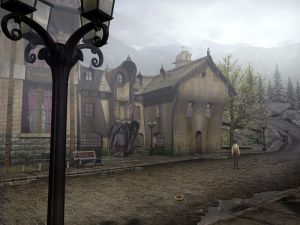Syberia
 Syberia (not to be confused with the cheesy 1994 FMV game Cyberia) is an atmospheric point-and-click adventure by Benoit Sokal, a Belgian comic book artist and game designer. What is it with Belgian comics and adventure games? Well, in this particular case, I think it has a lot to do with living in the shadow of Hergé. Like the adventures of Tintin, Syberia is a story of traveling to distant lands where everything and everyone is a little odd, rendered in a style that’s fanciful and caricatured, but at the same time oddly restrained about it. This is one of those adventure games with pre-rendered backgrounds under 3D characters and other animated elements. The art is gorgeous, very old-world picturesque with intense clarity of detail and a very pleasing distance haze.
Syberia (not to be confused with the cheesy 1994 FMV game Cyberia) is an atmospheric point-and-click adventure by Benoit Sokal, a Belgian comic book artist and game designer. What is it with Belgian comics and adventure games? Well, in this particular case, I think it has a lot to do with living in the shadow of Hergé. Like the adventures of Tintin, Syberia is a story of traveling to distant lands where everything and everyone is a little odd, rendered in a style that’s fanciful and caricatured, but at the same time oddly restrained about it. This is one of those adventure games with pre-rendered backgrounds under 3D characters and other animated elements. The art is gorgeous, very old-world picturesque with intense clarity of detail and a very pleasing distance haze.
The story starts in an alpine town called Valadilène, where the player character, Kate Walker, a lawyer from New York, has come to arrange a large corporation’s purchase of the old toy factory that forms the basis of not only all the town’s wealth, but much of its machinery and architecture: there’s hardly anything, even in the office of the town’s elderly notary, that isn’t in some way connected to a custom clockwork automaton in a metal top hat. The opening cutscene begins with a funeral procession composed entirely of automatons. Of course, in a sense every single character in the game is an automaton, a machine with fixed inputs and outputs, canned dialogue, and scripted motions that play out as if driven by an uncoiling spring. But I don’t think I’m supposed to have made that connection.
The factory deal is complicated by the owner’s death, which forces you to track down a lost heir, who apparently went off to Siberia on a special clockwork train to look for mammoths or something. Presumably in the process Kate will learn valuable lessons about what’s important in life and stuff; in the beginning, she’s pretty clearly the city slicker amongst simple rural folk, and there’s really only one way that can develop.
I recall getting just past Valadilène to the second chapter before stopping playing this back when it was new. I’m not quite up to that point yet now. I’m finding that I’ve forgotten most of the first chapter, and have to rediscover the solutions to puzzles. There was one particular bit that I remembered quite clearly, though, because it stuck in my craw so badly the first time. At one point, a boy demands that you draw a picture of a mammoth for him. You cannot progress further into the game until you comply. You have a pencil and paper (treated as a single inventory item), but I could not for the life of me figure out how to use them to draw a mammoth. It turned out that you have to apply them to a small carving of a mammoth that I had failed to notice etched into a nearby wall. The problem here isn’t just that the carving is easy to miss, it’s that there’s no clear reason why it’s necessary. Can’t Kate draw a mammoth freehand? Everyone knows what a mammoth looks like. Or, if that’s unacceptable, the game should at least tell us that it’s unacceptable: have the kid look at Kate’s unaided handiwork and say “That’s not what mammoths look like!” or something.
So anyway, that’s what I’m anticipating in the later parts of this game. Lovely art and lousy puzzles.
 Comments(1)
Comments(1)
Pretty much. Though I don’t recall anything in Syberia 1 being quite as bad as the music puzzle in Syberia 2 (I hate those). It also suffers from a disappointing lack of interactivity. You can’t click on much that’s not puzzle related, and Kate has little of interest to say about them when you can. Coming off The Longest Journey, as I was at the time, I felt that people who were comparing Syberia positively to that game were way off base.